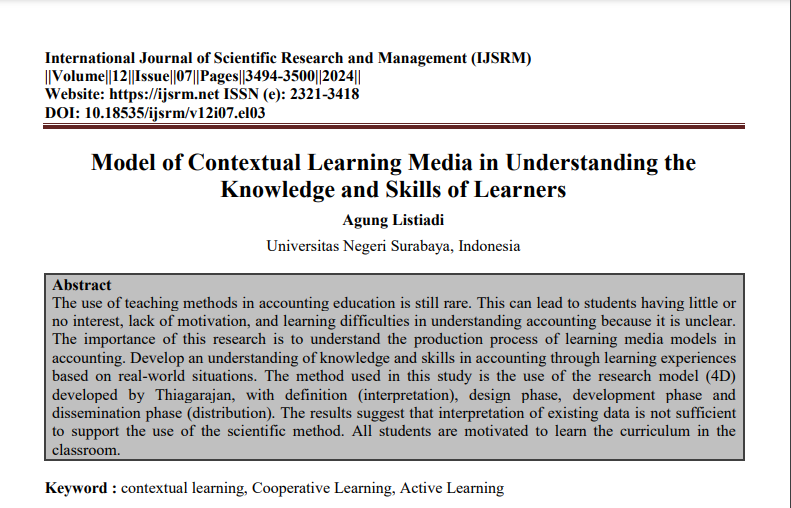
Submission to VIJ 2024-07-22
Keywords
- contextual learning,
- Cooperative Learning,
- Active Learning
Copyright (c) 2024 Agung Listiadi

This work is licensed under a Creative Commons Attribution 4.0 International License.
Abstract
Abstract
The use of teaching methods in accounting education is still rare. This can lead to students having little or no interest, lack of motivation, and learning difficulties in understanding accounting because it is unclear. The importance of this research is to understand the production process of learning media models in accounting. Develop an understanding of knowledge and skills in accounting through learning experiences based on real-world situations. The method used in this study is the use of the research model (4D) developed by Thiagarajan, with definition (interpretation), design phase, development phase and dissemination phase (distribution). The results suggest that interpretation of existing data is not sufficient to support the use of the scientific method. All students are motivated to learn the curriculum in the classroom.
References
- Abraham A. (2006). Perceptions of the Linkages between teaching Contexts, Approaches to Learning and Outcomes. Research Online institutional repository for the University of Wollongong. pp. 9-21.
- Belkaoui, A. R. (1992). Accounting theory. 3rd ed. New York: 5th ed. Boston.
- Hudson Clemente Charles. (2007). Contextual Teaching and Learning for Practitioners. Journal of Systemic, Cybernetics and Informatics Vol 6. pp. 54-58.
- Carroll Margaret Kelly. (2011). Fun and Games in Higher Education. Eastern Education Journal Vol 40(1) Spring. pp 23 – 32.
- Dale, E.(1969). Audiovisual methods in teaching. 3rd Ed. New York: Holt.
- Horton William. (2002). Speakers_ experiences and audience design: knowing when and knowing how to adjust utterances to addressees. Journal of Memory and Language 47.pp. 589–606
- Jones Karrie. (2008). Making Cooperative Learning Work in the College Classroom: An Application of the ‘Five Pillars’ of Cooperative Learning to Post-Secondary Instruction. The Journal of Effective Teaching, Vol. 8, No. 2.pp. 61-76
- Morable Linda. (2000). Using Active Learning Techniques. Exclusive copyright is retained by the U.S. Department of Education, the Texas Higher education Coordinating Board, and Richland College.
- Rohrer D., (2010). Tests enhance the transfer of learning. Journal of Experimental Psychology: Learning, Memory, and Cognition, Vol 36.pp.233-239.
- Silberman Mel. (2001). Active Training Techniques: Promoting Learning by Doing. San Francisco: Published by Pfeiffer An Imprint of Wiley.
- Schinske Jeffrey N. (2011). Taming the Testing/Grading Cycle in Lecture Classes Centered On Open-Ended Assessment... National Science Teachers Association (NSTA).Reprinted with permission from Journal of College Science Teaching, Vol. 40, No. 4, 2011.pp.46-52